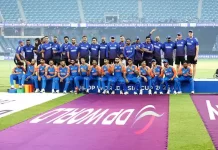Former RCB director of cricket Mike Hesson and KKR strategy consultant Nathan Leamon offer their thoughts on why it might occur this year.
Who will qualify for the postseason? Who are the front-runners? Will the seventh retire? Let’s set aside those often asked questions and pose a fresh one that relates to the 2025 Indian Premier League: Will it be the first time a team scores 300?
That may seem like clickbait, but given how frequently batting records were broken in the 2024 Indian Premier League, it is highly significant. Prior to the most recent season, the highest IPL total had not been reached since 2013. In 2024, RCB’s score of 263 for 5 against the Pune Warriors was surpassed four times. Eight of the 17 IPL seasons have seen 250-plus totals, with Sunrisers Hyderabad’s 287 for 3 against Royal Challengers Bengaluru last year serving as the new high point.
Against the Lucknow Super Giants, its openers Travis Head and Abhishek Sharma, better known as Travishek, hammered a target of 166 in 58 balls, or in 9.4 overs. These incredible batting achievements weren’t an anomaly. In IPL 2024, practically all batting metrics showed improvement.
In T20 cricket, the 300-peak has already been reached three times in men’s cricket and five times in women’s cricket. In a high-profile match involving teams of a particular caliber, it has just never been done. The Sunrisers threatened it twice in the previous IPL, and India got within three runs of 300 against Bangladesh last year.
Who could be able to breach the 300-barrier this season, and how?
When England reached the three highest totals in men’s ODI cricket, Nathan Leamon, their chief analyst, predicted that 300 would be reached. Since 2021, he has served as a strategy consultant with the reigning champion Kolkata Knight Riders, having watched the IPL change from the outside.
The Impact Player rule, which the IPL implemented in 2023, is the driving force behind record scores and turbocharged batting. The regulation, which offers teams more batting depth, has enabled batters to play at a high pace and place a lower price on their wicket, much like a performance-enhancing stimulant. According to Leamon, the regulation also encouraged teams to target aggressive hitters during the 2025–2027 cycle’s big auction. “What some teams realised was that you had to increase the aggression of your line-up all the way through if you are going to maximise the advantage of that extra batter.”
After batters no longer fear leaving the field, it becomes “dangerous” for bowlers and coaches, according to Mike Hesson, who served as RCB’s team director from 2020 to 2023. “If you remove the worry of getting out, it’s amazing what you can do,” Hesson asserts. And that’s the difficulty. There was always a compromise between “hey, we don’t want to lose more than one wicket or whatever,” which is why it used to be 52 or 54 and then 58 [par] in powerplay.
The increase in aggressive batting from 2023 to 2024 is supported by data. Last season, the powerplay’s first-innings run rate increased by 2.49%. The death overs (17–20) saw a 3.62% increase in run rate, while the middle overs (7–16) saw the biggest increase (5.77%). In 2024, there is a notable rise in first-innings run rates compared to 2022, the season prior to the implementation of the Impact Player rule: 10.8%.
